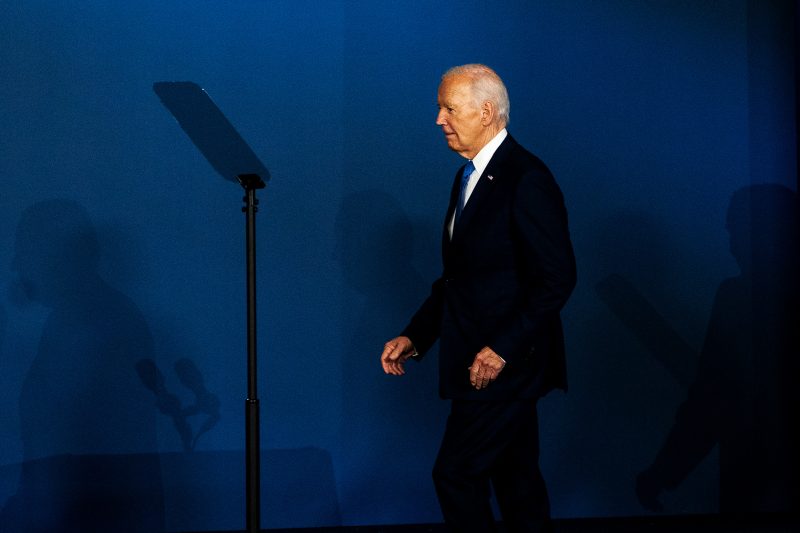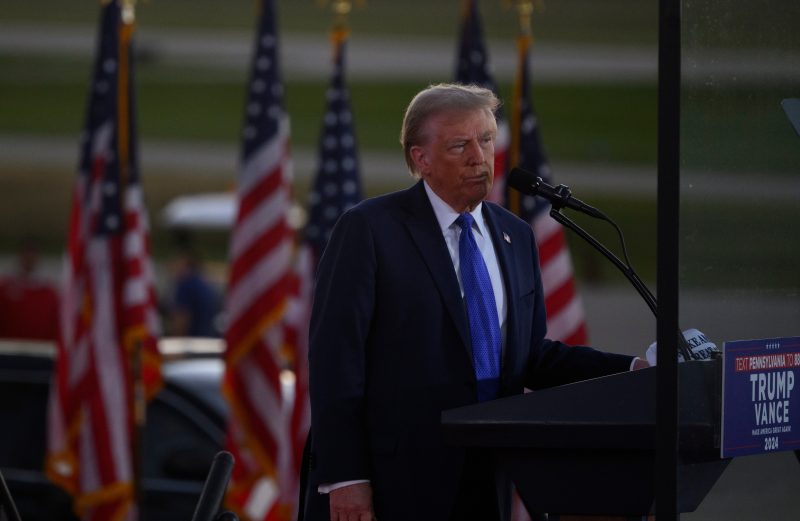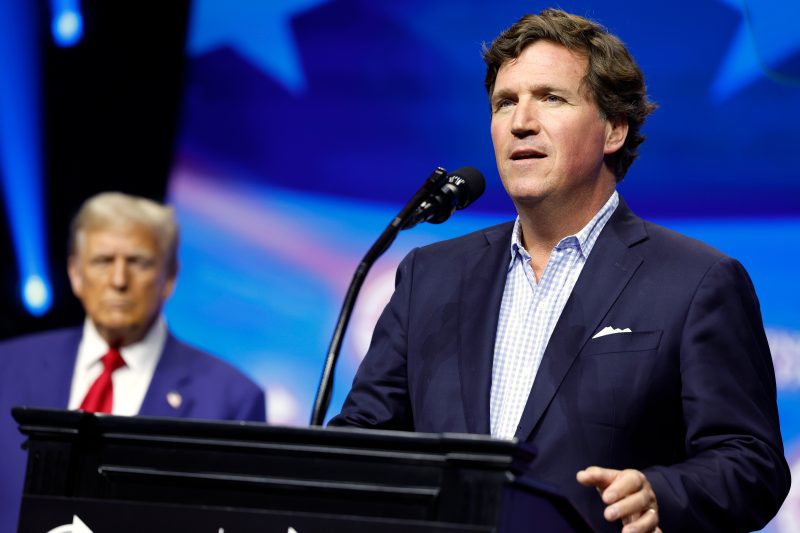
Biden’s path to victory narrows in wake of damaging debate performance
President Biden told reporters Thursday that unless his team comes to him with an unequivocal and blunt message — “There’s no way you can win” — he has no plans to reconsider his decision to stay in the presidential race.
But following his halting and politically damaging debate performance just over two weeks ago, there are growing Democratic fears that Biden’s path to victory in November has become significantly narrower, giving him almost no margin for error.
Former president Donald Trump, by contrast, now faces a potentially expanded electoral map, giving him multiple possible routes to victory and more wiggle room.
Despite national polls that show only modest slippage for Biden since his June 27 debate debut, his road to the necessary 270 electoral votes through key battlegrounds has further contracted. This is especially true in Sun Belt states such as Arizona, Georgia and Nevada — which Biden won in 2020 — as well as in North Carolina, which he lost by just 1.3 points four years ago and which his campaign had hoped to put back into play.
“The map is a narrower path to 270 for Biden, and a wider one — with more cushion — for Trump,” said Amy Walter, editor in chief of the Cook Political Report. “Even before the debate, the path for Biden was getting narrower. … The whole point of the debate for Biden was he was on his heels and needed to go on offense and change the narrative and momentum and math with this debate, and that’s obviously not where we are.”
“And that,” Walter said, “is why there is such panic among Democrats, because there is literally no cushion.”
A memo that top Biden campaign staffers sent to supporters Thursday argued that the president has “multiple pathways to 270 electoral votes, with a focus on the Blue Wall states” — Michigan, Pennsylvania and Wisconsin. If those are the only swing states he wins, Biden also needs to win the congressional district in Omaha to hold on to the White House.
These states are “the clearest pathway to that aim, but we also believe that the Sun Belt States are not out of reach,” the memo continued.
Democrats and Republicans alike both privately and publicly say that — for now, at least — they believe the Sun Belt is out of reach, meaning Biden would have to hold Michigan, Pennsylvania and Wisconsin to have any chance of returning to the White House.
In 2020, he flipped all three states into the Democratic column from 2016, winning them all by a narrow margin.
The panic among Democrats was sparked by the first presidential debate last month. Biden struggled to complete sentences, often seemed confused when answering questions and largely failed to challenge Trump on his agenda. Biden aides had hoped the debate would mark a turning point in the election and help Biden regain support among key constituents that have faded away during his presidency.
Instead, the debate turned into a political disaster, leading nearly two dozen Democratic lawmakers to privately or publicly call on him to step aside as of Friday amid fears he will lose to Trump in November. Biden’s performance has convulsed the Democratic Party as politicians, strategists, donors and voters engage in anguished debate over whether Vice President Harris would pose a more formidable challenge to Trump.
Howard Wolfson, an adviser to Hillary Clinton’s 2008 presidential campaign who now works for former New York mayor Mike Bloomberg, said that when Democrats can play in traditionally red states, that means they are “in good shape” — but right now, he thinks the only three truly competitive states are the Blue Wall.
“There is no other path,” Wolfson said. “It is more likely we lose a blue state than win a red state. It is more likely we lose New Hampshire or New Mexico than we win Arizona or Nevada. The map is bad. It has really constricted.”
Trump pollster Tony Fabrizio was more blunt, saying that after the debate, his team was “tracking as many as 322 electoral votes.”
“At this juncture, I stopped counting at 25 different paths to 270,” said Fabrizio, who added that the Trump campaign views Georgia and Arizona as two pivotal states.
The Biden campaign resisted the idea that the president’s paths to victory have shrunk and said that while the three Blue Wall states may currently represent the strongest route to 270, it is hardly the only one.
“The reality is that we do have multiple pathways and we’ve always had multiple pathways to victory in this race,” said Dan Kanninen, Biden’s battleground states director.
Kanninen said that when the truly up-for-grabs voters start paying attention closer to November, the “political gravity” of what is at stake will become “undeniable” and the contrast between Biden and Trump will benefit Biden.
“It’s not that Trump has gained support,” he said. “It’s that we have some work to do to shore up our own support. And we have a plan to do it.”
The Biden campaign pointed to a $50 million media blitz announced the first week of July in battleground states — a group that includes not only the Blue Wall but also Arizona, Georgia, Nevada and North Carolina — as well as its robust on-the-ground presence as signs that it is ceding no states to Trump.
In Georgia, the Biden campaign has more than 120 staffers working in 16 field offices throughout the state, with eight more offices set to open next week. And in North Carolina, the Biden campaign has 20 campaign offices and more than 100 staffers — a number it plans to double by the end of the month.
The Washington Post’s presidential polling average right now shows that Trump leads Biden in six of the seven battleground states that are most likely to determine the election. In the Blue Wall states, the polls are so close that the race remains within the margin of error. But in the Sun Belt states — Arizona, Georgia, Nevada and North Carolina — Trump’s advantage is more significant: He leads Biden by six points in Georgia and by five points in the other three.
Republican strategists working for independent groups supporting Trump, who have their own internal polling, have not yet declared victory.
“The only number that has significantly moved outside the margin of error was the too-old ‘Grandpa’ question,” said Dave Carney, the strategist for Preserve America, a pro-Trump super PAC funded by Las Vegas Sands owner Miriam Adelson that plans to start spending in the Blue Wall states in late July. He added that Trump was ahead, though inside the margin of error, in those states.
MAGA Inc., another major advertiser for Trump, announced Friday that it was canceling reservations in Georgia to add money to Arizona — a state Biden flipped to Democrats in 2020 — where some research showed recent Biden gains.
“There may be chaos in D.C., but there’s still a race to run,” said a senior official at the group, who spoke on the condition of anonymity to describe internal data. “Arizona is a state we have watched closely, and recent internal polling has led to a shift in resources. The floor hasn’t yet fallen out for Biden, but a couple sticks of dynamite strapped to the floor boards should change that.”
Among Democrats, there is also some private consternation that traditionally blue states like Minnesota, New Hampshire, New Mexico and Virginia may now be in play — or may at least represent states where Democrats have to allocate resources playing defense.
“In all fairness, I put Minnesota and Virginia on the map back in May,” Fabrizio said, adding that the Trump campaign views them as true “battleground states” rather than reaches.
The Democratic Party chairs in Minnesota and New Hampshire said this week that they expect their states to be tight, single-digit races, though they were not yet detecting any sharp polling movement since the debate.
“Trump is a trophy collector — he collects trophy properties and trophy wives,” said Ken Martin, chair of the Minnesota Democratic-Farmer-Labor Party, which is the name used by that state’s party. “There is no bigger trophy than taking Minnesota.”
Independent groups supporting Biden have begun conversations about revisiting their own advertising plans in southern states, though no decisions have been made because of doubts over whom the nominee will be and how he or she will fare in polls, according to people familiar with the conversations. The two biggest groups running ads backing Biden — Future Forward and American Bridge — have not been on the air in recent weeks.
“The polling is obviously not what we hoped for,” said former Nevada governor Steve Sisolak, a Democrat, who narrowly lost his reelection race in 2022. “The debate was not what we hoped for, but it’s still four months away.”
He added: “We need a change in narrative to Donald Trump and his lies.”
Some Democrats remain hopeful that the Republican National Convention, which starts Monday in Milwaukee, will provide a reset and refocus the nation on Trump, his policy agenda and his legal challenges. But Biden is slated to sit for a prime-time interview with NBC News on Monday and may participate in additional interviews later in the week, opening new opportunities for critics to seize on any mistakes.
Nancy Zdunkewicz, a Democratic pollster and founder of Z to A Research, has told fellow Democrats that Biden is no longer safe in any state he won by 10 points or less four years ago.
“My back-of-hand math is: If we’re worried about seats or districts or states that Biden carried by nine, 10, 11, 12 points, and he’s running neck-and-neck with Trump — or even a couple of points behind — that’s pretty bad,” Zdunkewicz said. “That means we can’t count on them, and that’s what’s freaking out all of these members.”
A Washington Post-ABC News-Ipsos poll this week shows Biden performing worse with key Democratic groups — young voters, Black voters and Hispanic voters — than he did four years ago. Among registered voters ages 18 to 29, Biden leads Trump 47 percent to 41 percent — far smaller than his 24-point advantage in 2020 exit polls and comparable sources. Among Black registered voters, Biden leads Trump 79 percent to 15 percent — a slight drop from the Black voters who favored Biden 87-12 in exit polls. And among Hispanic voters, Biden leads Trump 49 percent to 42 percent — again far smaller than his 33-point advantage in 2020.
Despite those drop-offs, Biden nonetheless remained tied with Trump in the Post-ABC-Ipsos poll, and the president outperformed his 2020 support among White voters, men and people ages 65 and older.
Many Democrats agree that Biden did not suddenly plummet in the polls following the debate. But they worry that the event did not serve its intended purpose — to transform the race into a referendum on the former president rather than the current one — and now say Biden has even more ground to recover if he hopes to pull ahead of Trump by Election Day on Nov. 5.
“I don’t think the debate changed anything, but the whole point of the debate was to change everything,” said a Democratic strategist currently working on several House and Senate races. “We were losing and we had to shift the conversation, and instead we shifted the conversation onto the wrong subject.”
A year ago, Doug Sosnik, who was former president Bill Clinton’s political director in the White House, said he assessed Trump had a “marginal advantage” over Biden in reaching 270 electoral votes. As states in the Sun Belt have drifted away from Biden, Sosnik’s outlook for Biden has become more pessimistic.
“If you’re looking at this clear-eyed, it’s hard to not look at where the race stands and think Trump has a pretty significant advantage,” he said.
Zac Petkanas, president of Petkanas Strategies who ran rapid-response operations for Hillary Clinton’s 2016 campaign, acknowledged that the contest is shaping up to be “tough, competitive, and hard-fought” and that “Donald Trump could win and Joe Biden could win.” But he said that four months from Election Day is far too early to draw any meaningful conclusions.
“I don’t buy the idea that certain battleground states are off the table in July,” he said. “The freakout is that we have a competitive race on our hands, and that’s the state of play in July.”
Scott Clement in Washington contributed to this report.



